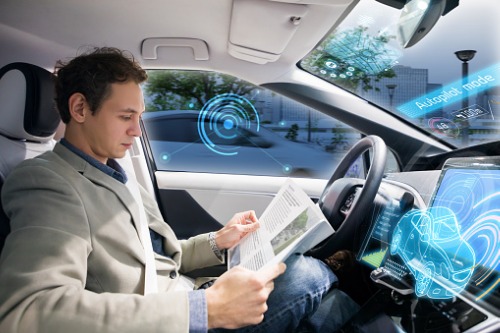

Testing of autonomous vehicle technology really ramped up a gear in 2018. After a brief hiatus following the fatal self-driving Uber crash in Tempe, Arizona, autonomous vehicle manufacturers and other interested stakeholders – including insurance firms – are now accelerating their road-testing programs. They’re being fuelled by the introduction of rules, regulations and official legislation aimed at making roads safer with the implementation of autonomous technology.
The United Kingdom is arguably leading the way with regards to legislation and codes of practice around autonomous vehicle operations. In July 2018, the UK government passed the Automated and Electric Vehicles Act 2018, setting out a regulatory framework that brings automated vehicle insurance in line with “longstanding motor insurance practice”. The Act ensures that British motorists are covered both when they’re driving and when the driver has legitimately handed control to the vehicle.
Elsewhere, legislative support has not been so easily granted. The United States had to pass a bill which barred individual states from blocking driverless car testing after some imposed strict regulations citing concerns over public safety. Canada also lags behind the UK, but change is slowly happening. In December 2018, Canadian transport minister, Marc Garneau, introduced Testing Highly Automated Vehicles in Canada: Guidelines for Trial Organizations, a joint collaboration between Transport Canada and the Canadian Council of Motor Transport Administrators (CCMTA), which would support more testing and development of autonomous vehicle technology.
“Controls over autonomous vehicle testing are very important,” said David Williams, technical director at AXA Insurance. “You can’t rush these things through. You’ve got to do the simulation miles and the real road miles – and you’ve got to do them in the appropriate environments and with appropriately trained people. At AXA, we believe autonomous vehicle technology will be an essential part of making our roads safer. The last thing anyone wants is for people to rush this technology through and then have some serious accidents that destroy people’s confidence.”
It could be argued that public ‘confidence’ is precisely the thing lacking around autonomous vehicle technology at the moment. That’s largely due to the smorgasbord of unanswered questions around issues like safety (what criteria will be used to define safety in the autonomous era?), liability (when something inevitably goes wrong, who’s at fault?), accessibility (who can safely use a driverless car?), and so on.
Tom Karol, general counsel – federal, at the National Association of Mutual Insurance Companies (NAMIC) in the US, commented: “Safety is a key area of the autonomous vehicle debate. It’s the primary, if not the sole reason, for driverless vehicles to exist. But one of the things we have to get our heads around is how to determine this safety. There are numerous questions that need answering. How much safer [than human drivers] do we want autonomous vehicles to be? Is 1% safer enough, or do we need 10%, or 100%? Yes, a driverless car won’t fall asleep, but can it identify a bicycle? Can it determine a stop sign in the snow? Can it identify a paper bag versus a child running across the street?”
One issue raised by Karol - and debated regularly by experts – is the ability of autonomous vehicles to cope with difficult weather conditions like snow and fog. Snowy conditions have been described as particularly problematic because they can cause problems for the cameras and sensors that autonomous vehicles use to perceive the world around them.
“A human being might say: ‘I found it really difficult driving home last night because there was lots of snow and I couldn’t see the road edge.’ That’s a human worry when it comes to driving in hard conditions. But when it comes to autonomous vehicles, as long as they have the right variety of sensors and cameras, then they can cope with any weather conditions a human being can, more safely,” Williams told Insurance Business. “Sensor technology like Radar and Lidar can penetrate objects and can identify things with much greater clarity and at a much greater distance than the human eye. It’s about having an appropriate blend of technology to make these vehicles as safe as they can be.”
As autonomous vehicle technology continues to advance, and testing becomes more thorough, the insurance industry is really starting to engage. Not everyone can be an expert, but they do need to educate themselves about the risks, according to Williams. Brokers, for example, need to keep up to date with the latest technological advances and the latest legal and regulatory decisions so that they can keep their clients informed as interest in autonomous vehicle technology continues to accelerate.
Mike Hudzik, head of casualty underwriting, Swiss Re, commented: “We’re very bullish in our preparations for autonomous vehicle technology at Swiss Re. We think autonomy will bring a strong set of positives and will help to reduce loss frequency in terms of collision claims, distracted driving and so on. Moving forwards, the real challenge is going to be making the transition towards autonomy. The expectations are that the automotive industry can introduce autonomous technology slowly and it can gradually gain momentum. However, even if the transportation industry embraces autonomous technology, that doesn’t necessarily mean the world around the industry will embrace it with the same speed or the same degree of momentum.
“When do we think autonomous vehicle technology will make a huge difference to insurance? Probably not in the near-term. It’s going to take some time before we see the benefits become clear in the industry. What we can say with certainty is that once we have fully autonomous vehicles, motor risks are likely to decrease tremendously, and product liability will become more important than ever. It’s going to be exciting to experience how this technology changes the industry.”
